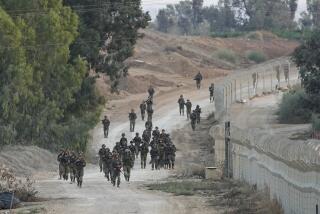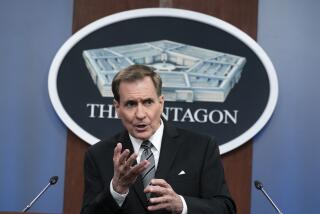Grenada Invasion Plagued by Mistakes, 2 Reports Say
- Share via
WASHINGTON — The U.S. invasion of Grenada in October, 1983, once trumpeted by the Reagan Administration as a triumph of military planning, was actually plagued with foul-ups that required commanders on the ground to improvise in order to avert disaster, two Pentagon reports disclose.
U.S. assault helicopters were ordered directly into areas swept by enemy anti-aircraft gums; American troops found themselves groping their way through hostile territory with inaccurate maps and balky radios, and at one point a Marine commander nearly ordered an assault on the Venezuelan Embassy because he did not recognize the flag it was flying, according to a Marine Corps post-mortem on the operation that was released Tuesday.
The Marine report, and an earlier analysis prepared for the joint Chiefs of Staff by Adm. Wesley L. McDonald, the invasion commander, support some of the charges made by military critics of the operation--that the landings were hastily planned, supported by inadequate intelligence, and complicated by glitches in coordinating units from the four military services.
Both reports called the invasion a success. The U.S. troops overwhelmed smaller Grenadian and Cuban forces and evacuated several hundred American medical students with relatively light losses of 19 U.S. dead and 115 wounded. But the Marine analysis makes it clear that the nine-day campaign could have produced much higher losses if not for the quick thinking of ground commanders and the weakness of the enemy forces.
“The Cuban defenses were hastily organized, incomplete and in some places made poor tactical use of the terrain,” the Marine report said. “All the evidence indicates that, given more time, the enemy would have been much better prepared.”
Moreover, the two reports found, the helicopters relied on by U.S. forces for their landings turned out to be unexpectedly vulnerable to anti-aircraft fire, even though the Cuban and Grenadian forces on the island did not use surface-to-air missiles. Most of the 19 American combat deaths in the invasion resulted from enemy fire.
A basic problem, the Marine report said, was a shortage of usable maps and “an almost total lack of information concerning suitable beaches and helicopter landing zones on Grenada.” The Marines ended up relying in part on the memory of an officer who had vacationed on the island and who was in the assault force by chance.
The report also recounted the Marines’ search for armed Cubans who had been reported in the area of St. George’s, the capital. A Marine unit first moved to seize the Richmond Hill prison but arrived to find that the prisoners had already been released by a correspondent for Time magazine.
The Marines than “commenced attack” on Ft. Adolphus, marked on their maps as a military position. “Because there was a flag of unknown type flying over the Ft. Adolphus compound, the company commander considered using (artillery) to soften what he believed to be a possible Cuban stronghold.
“This consideration was reversed...The decision not to (use artillery) was sound because, as it turned out, Ft. Adolphus was the Venezuelan Embassy.”
More to Read
Sign up for Essential California
The most important California stories and recommendations in your inbox every morning.
You may occasionally receive promotional content from the Los Angeles Times.











